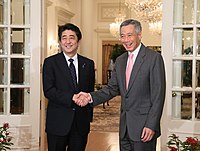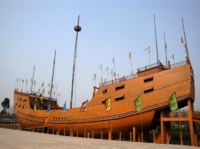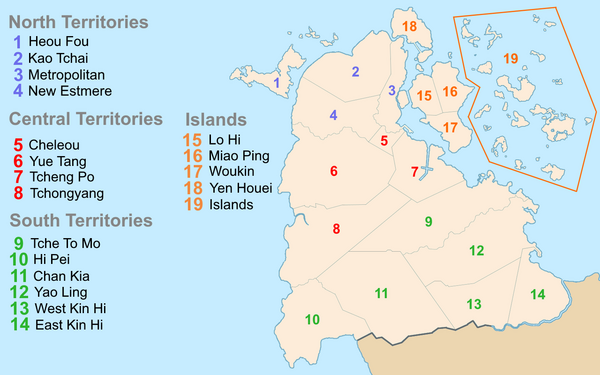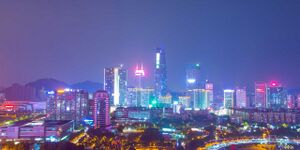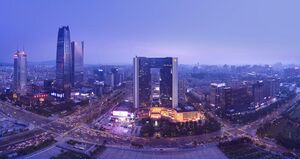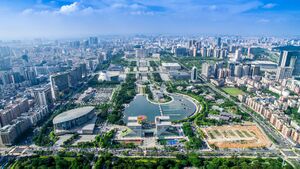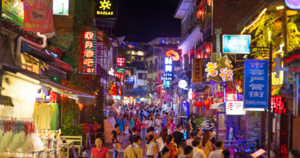Kintao: Difference between revisions
Britbong64 (talk | contribs) |
Britbong64 (talk | contribs) No edit summary |
||
| Line 99: | Line 99: | ||
| footnotes = | | footnotes = | ||
}} | }} | ||
'''Kintao''', officially the '''Kintao Autonomous Administrative Territory of the Auspicious Republic of Shangea''', also known as '''Jindao''' or '''Kintou''' in [[Senria]], is a special administrative region situated in western [[Shangea]], whom it shares its sole land border with. With 6,541,201 people and an area of 1,125.6 km², around 60% of which is water, it is one of the most densely populated regions in the world. The city of [[Cheleou]], within the Kintao metropolitan area, is the most densely populated city in [[Kylaris|the world]], with a population of 2,541,205 and an area of 63.83km² (including the Tan Pei, Tang Kieou, Satratown and Wei Kan districts), the city has a population density of 39,812 people per square kilometre. | '''Kintao''', officially the '''Kintao Autonomous Administrative Territory of the Auspicious Republic of Shangea''', also known as '''Jindao''' or '''Kintou''' in [[Senria]], is a special administrative region situated in western [[Shangea]], whom it shares its sole land border with. With 6,541,201 people and an area of 1,125.6 km², around 60% of which is water, it is one of the most densely populated regions in the world. The city of [[Cheleou]], within the Kintao metropolitan area, is the most densely populated city in [[Kylaris|the world]], with a population of 2,541,205 and an area of 63.83km² (including the Tan Pei, Tang Kieou, Satratown and Wei Kan districts), the city has a population density of 39,812 people per square kilometre. | ||
Latest revision as of 01:34, 27 November 2022
Kintao 金岛 | |||||
|---|---|---|---|---|---|
Autonomous administrative territory of Shangea | |||||
Kintao Autonomous Administrative Territory of the Auspicious Republic of Shangea
| |||||
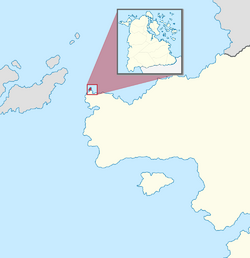 Kintao in western Shangea | |||||
| Sovereign state | Shangea | ||||
| Tienwei Island Treaty | May 18, 1857 | ||||
| Community of Nations Mandate | February 20, 1936 | ||||
| Kintao Treaty | February 1, 1991 | ||||
| Transfer of sovereignty from the CN | April 10, 2009 | ||||
| Administrative centre | Kao Louen Tsouen | ||||
| Largest district | Metropolitan | ||||
| Official languages | Shangean Gaullican | ||||
| Ethnic groups (2022) | 94.6% Shangean 1.1% Senrian 0.7% Estmerish 2.5% Other | ||||
| Religion (2022) | 44.1% Zohist 38.2% Solarian Catholic 15.6% Irreligious 2.1% Other | ||||
| Leaders | |||||
• First Minister | Kouo Tchen-ya | ||||
• First Secretary | Leao Tsai | ||||
| Legislature | Biao | ||||
| Area | |||||
• Total | 1,125.6 km2 (434.6 sq mi) | ||||
| Population | |||||
• 2021 estimate | 6,814,557 | ||||
• 2019 census | 6,541,201 | ||||
• Density | 15,055/km2 (38,992.3/sq mi) | ||||
| GDP (PPP) | estimate | ||||
• Total | $553.8 billion | ||||
• Per capita | $82,819 | ||||
| GDP (nominal) | estimate | ||||
• Total | $517.3 billion | ||||
• Per capita | $77,361 | ||||
| Gini (2020) | high | ||||
| HDI (2020) | very high | ||||
| Currency | Jindanese nacar (JNN) Shangean kuai (SHK) | ||||
| Date format | yyyy-mm-dd | ||||
| Driving side | right | ||||
| Calling code | +891 | ||||
| Internet TLD | .jn | ||||
Kintao, officially the Kintao Autonomous Administrative Territory of the Auspicious Republic of Shangea, also known as Jindao or Kintou in Senria, is a special administrative region situated in western Shangea, whom it shares its sole land border with. With 6,541,201 people and an area of 1,125.6 km², around 60% of which is water, it is one of the most densely populated regions in the world. The city of Cheleou, within the Kintao metropolitan area, is the most densely populated city in the world, with a population of 2,541,205 and an area of 63.83km² (including the Tan Pei, Tang Kieou, Satratown and Wei Kan districts), the city has a population density of 39,812 people per square kilometre.
Originally a fishing village and market town Kintao would first gain prominence as the capital of the Qing Kingdom during the Four Kingdoms period with the port of Kintao being a hub for trade in the southern Coius region. The city would be sieged by Senria during the Seikou War and the Qing would come under Shangean subjugation under the Tao dynasty. The city continued to flourish under Tao control as more resources and revenue from mainland Shangea were directed in the way of the city due to the decreased trade regulations between the two states. Kintao became a colony Gaullica after it was relinquished by Shangea as a treaty port in 1857 as per the Tienwei Island Treaty, Kintao acted as a naval base for Gaullica (and Shangea) throughout the Great War. After Gaullica's loss in the war, the city's sovereignty was transferred to Community of Nations with Senria and Estmere jointly administrating the city as a condominium. The city underwent very strong economic growth but would be marred by protests and labour agitation. The 1986 protests would spur the CN to undertake democratic reforms and begin the process of transferring the city to Shangean control. In 2004, the CN and Shangea signed the Jindao Treaty, an agreement which promised the sovereignty of Kintao to be returned to Shangea in exchange for the customs of rights of the city to remain unchanged and guaranteed. The CN officially relinquished sovereignty of the city in 2009, returning it to Shangea after 151 years of non-Shangean rule. Kintao acts as an Autonomous Administrative Territory (AAT) of Shangea, whose legislature and government is separate from that of the mainland.
A bustling city in western Shangea, Kintao is a major resort city with one of the highest tourists-per-capita of any city in Coius. The Jade Square in central Jindao is renowned for its wide assortment of cultures, cuisines and activities, with entertainment such as theatres, casinos and restaurants adorning much of the square. It is one of the highest recipients of tourism revenue and tourism accounts for most of country's economy.
Kintao has high rates of urbanisation centred around the main Kintao city, with one of the highest Human Development Indexes in the world, standing at 0.936. The Kintian government is working on increasing residential capacity on the outlying islands as well as reclaiming land from the sea to use as residential suburbs and estates.
Etymology
The first instance of the city being called "Jindao" is from the early 2nd century, when Xiao settlers began to inhabit the city and naming it after the fabled beaches on modern-day Woukin Island. Despite its etymology being incorrect for the city itself, the name has remained in use to this day. Jindao has also been known under several different similar names, with "Jindau" sometimes being used to refer to the city and "Chintow" being the official name of the city whilst it was under Gaullican rule and also partially under Estmerish rule until the postal romanisation stopped being used in X, where it was renamed to its traditional name.
History
Jindao was first settled in the 2nd century AD, when Shangean settlers migrated in from western Shangea. The Shangean settlers brought their customs and traditions of classical antiquity Shangea to the city and it effectively functioned as an offshoot of Shangea despite the city being an independent entity. The knowledge of rice cultivation was brought from the mainland and the city flourished as an ideal place for rice growth and farming. Due to its unique climate, Kintao was initially a slow-developing city, with most of the city being used exclusively for rice farming. In 411 AD, Shu Biao declared himself the Emperor of the Qing Sun (one of the four successor claimants of the Sun dynasty) during the Four Kingdoms period with Kintao being the capital of the Qing Kingdom having control of the entire Kaoming peninsula.
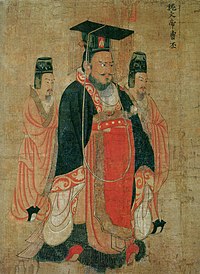
As the capital of the Qing Kingdom, Kintao became the site of irrigation projects and elaborate palaces venerating Shu Biao and his descendants with sea walls and levees controlling the water system around the city. The Qing would remained isolated from the other kingdoms with the maritime trade into Kintao making it very prosperous compared to other cities in the region.
Kintao became a refugee haven for the upper-class Shangean fleeing from infighting during the period of the Four Kingdoms, with old members of Sun royalty as well as Sun loyalists who owned land in mainland Shangea fleeing to the city in search of safety and refuge. The vast amounts of wealth that came into the city allowed Kintao to be built up quickly and by around 520 AD the city was technologically on par with the mainland for the first time in its history. Many modern day districts were first referenced during the time of the city's restructuring, including Tulihe and Laoshizhai in King Shu Tai's census of the city in 534 AD, which recorded a population of 79,000. The city would be sieged and occupied by Senria during the Seikou War from 496-503. The Seikou War would lead to the Qing to enter a period of gradual decline and in 685 would be fully annexed into the Tao dynasty with Kintao losing its status as a capital.
| Part of a series on the History of Kintao |
| Historic rulers of Kintao |
|---|
   |
| Sun dynasty |
| 100 – 400 |
| Qing kingdom |
| 411 - 691 |
| Tao dynasty |
| 691 - 1356 |
| Jiao dynasty |
| 1356 - 1661 |
| Western Jiao |
| 1661 - 1694 |
| Toki dynasty |
| 1694 - 1857 |
| Empire of Gaullica |
| 1857 – 1933 |
| Republic of Senria |
| 1933 – 1937 |
| Community of Nations |
| 1937 – 2006 |
| Auspicious Republic of Shangea |
| 2006 – |
Kintao served as an important naval port during the wars with Senria that were waged throughout the Tao era. Opinion of the Tao dynasty in Jindao was poor due to the repression of pennisular customs in favour of more northern-oriented ones, and following the wars with Senria as well as the economic decline of the dynasty, Kintao supported the Jiao family in their rise to power in 1415. Among the reign of the first Jiao emperor, the wealth accumulated by trade coming into Kintao was often lavishly spent on things for the emperor himself. Kintao again served as an important naval port for the invasion of Senria, but the city was affected by the peasant uprising that ultimately led to Shangean defeat in the war. Tcheng Po was a peasant stronghold during the uprising. Sotirianity - mainly Solarian Catholicism - arrived in the 17th century and was repressed within Shangea and Kintao, but some underground sects of newly-converted worshippers developed, most notoriously the Tàiyáng lóng (太阳龙; "Solar Dragons"), who burnt down the north side of the Yuhan Palace in 1656 and attempted to assassinate the emperor of Shangea in 1657, while he was on a visit to Kintao. By the time the Solar Dragons rose to prominence, the Jiao dynasty had long been in decline, largely due to the growing influence of Solarian Catholicism and the economic consequences of their luxury spending. During the Jiao-Toki transition Kintao was a stronghold for Jiao loyalists in the Western Jiao kingdom under the Prince of Cao Liu Wenyan (the self-proclaimed Taiwu Emperor). It would eventually fall under the control of the Toki dynasty/
The Toki dynasty began change almost immediately, implementing a new government system akin to that of Senria's, changing some of the customs that had existed in Shangea for millennia. Kintao was also affected by this change, with the new Senrian government system increasing centralisation and making Kintao subjected to increased direct rule from Rongzhuo. The swift change of the ethnicity of the higher class of Shangean society angered most Shangean people, who hated seeing the people they had fought so long to undermine ruling over their lands. The existence of the Toki dynasty was the initial step in the development in Shangean nationalism and the loss of wars to many Euclean powers and the unequal treaties that followed only amplified and spread the newfound ideology. Ruler of the Toki dynasty oversaw many technological developments and the increase in free markets and capitalistic policies did wonders for the Kintian economy, skyrocketing free trade and economic growth in the port city which allowed it to quickly industrialise at a much faster rate than its mainland counterparts. Due to this, migration to Kintao increased, especially from the mainland. The Euclean powers invaded a declining Toki dynasty in the 1850s and imposed a series of treaties on the state, one treaty, the Tienwei Island Treaty, saw Kintao leased to Gaullica for an 80-year period.
Gaullica immediately sought out reform within Kintian society, introducing Solarian Catholic beliefs and repressing the native Shangean language in favour of Gaullican. In 1887, development of a rail network, both overground and underground, began in Kintao, and just two years later the first underground line was opened, travelling between East Kao Louen Tsouen and West Tulihe, beginning the now-expansive Kintian metro system. The introduction of Euclean technology and innovations bolstered Kintao's economy and it became a largely Euclean-influenced city in Coius. New sewage systems spanning the streets of Kintao were created in the late-1890s to early-1900s, drastically reducing disease spread throughout the city. Kintao once again served as an important army and naval outpost in Coius for Gaullica, giving the empire a base in southern Coius from which to project its influence from. Shangean and Gaullican troops and equipment were stationed in Kintao throughout the Great War and the city saw some of the first wars it had ever seen on its home shores during the conflict. Following Senrian landings across Shangea, the Battle of Kintao began in August 1933, with the subsequent Senrian Occupation of Jindao being completed by March the following year. After the Entente surrendered in 1935 Kintao was placed under the joint-authority of Senria, Estmere and Etruria under the jurisdiction of the Community of Nations.
Although initially governed by the three nations the withdrawal of Etruria from the Community of Nations would place the city under de facto Estmero-Senrian control. The post-war depression experienced by much of Euclea and Coius also encouraged widespread migration to Kintao, especially among the upper class and conglomerates in their countries. Taxes in Jindao were reformed in 1951 to attract large multinational corporations to base their operations in Kintao, allowing companies to avoid taxes through the lack of filed public accounts in Kintao and all countries with bilateral tax treaties with Kintao operating a policy of financial secrecy. The Community of Nations governance attracted criticism for widespread use of strike breaking and a lack of democratic accountability. During the early 1970s the administration begun a massive investment programme to raise living standards after persistent strikes had led to fear of a socialist revolt.
During the 1980s mass protests demanding representative governance led to the CN administration to allow the creation of an elected government albeit under CN oversight. The new government began to lobby for intergration into Shangea which had emerged as a key market for Kintian businesses. In 2004 the CN, Senria, Estmere and Shangea signed the Kintao Treaty agreeing that as long as Shangea preserves the autonomy and liberties of Kintao, the port will be returned back within five years. In 2009 was returned back to Shangea as an Autonomous Administrative Territory signalling the end of foreign colonial rule. Kintao's economy has continued to skyrocket through its taxing policy and the one city boasts a GDP more comparable to some countries, standing at just over $500 billion. Population growth in Kintao in increasing and the city is beginning to face a residential housing crisis with the amount of migration globally, although this has begun to be combatted with the construction of the Yue Tang Residential District, Yao Ling City and Heou Fou.
Government and politics
Kintao is an Autonomous Administrative Territory (AAT) of Shangea, characterised by increased autonomy from the mainland in many aspects of society and politics. The Kintao Agreement laid out the framework for the continuation of Kintian economic and administrative sovereignty following the transferral of the port back to Shangea in 2009. The law of Kintao acts as a basic uncodified constitution for the region, although Shangea reserve the right to impose the law of the Shangean constitution on the city.
The Biao, the regional parliament of Kintao, consists of three main entities:
- Executive: The First Minister and represents Kintao in official meetings as its de jure head-of-government, appointed by the Executive Council. The council itself is elected every five years in non-partisan elections, but under heavy regulation from Shangea.
- Legislature: The Legislative Council are responsible for the drafting of legislature and presenting it before the Executive Council (which is elected every five years in a non-partisan election). The Legislative Council also approves the fiscal budget for the territory and as the power to impeach a sitting First Minister with a three-quarters-majority vote. Unlike, the Executive Council, the Legislative Council is not subject to outside Shangean influence.
- Judiciary: Kintao's judiciary are tasked with the application of regional law as well as Shangean law. The judiciary is heavily connected with its counterparts in Shangea, and legal connections are often made between the two.
The Chief Executive, currently Kouo Tchen-ya, serves as the region's de facto head-of-state and its head-of-government, and can serve for unlimited five-year term. The State Preidium of Shangea appoints the First Minister with guidance from the elected Executive Council, composing of 20 members.
The Legislative Council consists of 25 members, all of which serve a 5 year term. The 25 members are split between the 19 districts of Kintao and 6 functional constituencies that represent corporations and organisations, high-ranking people and special interest groups. Political parties can run for the Legislative Council, but not for the Executive Council, as a result many send their party leader or other high ranking officials to campaign for executive election, while the main bulk of the party campaigns for the Legislative Council. A total of 4 political parties won seats in the 2015 Legislative elections.
Shangean national law does not usually apply within the region, and is one of the core principles in Kintian autonomy, the region operates its own separate laws enforced by the Judiciary. Kintao operates a separate immigration policy to the mainland, although work has been done to centralise the two systems in recent years.
Kintao is a demilitarised zone under international law and the population is exempt from conscription with Shangea barred from deploying its military there. The defence of the city is guaranteed by a gendarmerie force, the Public Security Corps. In times of war, Shangea can request to the Community of Nations to deploy troops to the city.
Administrative divisions
Kintao is divided into nineteen districts with hundreds of lower-level suburbs. Separate District Councils address individual problems within their represented district such as public funding (each district council is allocated a fiscal budget), cultural and religious promotion and events, public facilities and environmental policy. Before 2002, a rural council represented the villages of Chan Kia, Kushui and Kin Hi, but the council was abolished following urban expansion in the area and the construction of Yao Ling City.
Sociopolitical issues
Kintao is a democracy, employing universal suffrage for its Legislative and Executive Councils. This often proves difficult and acts as a hurdle for Kintao as mainland Shangea does not employ democracy in its government. Some Shangean pro-democracy advocates have relocated to Kintao to participate in its electoral system, and Kintao often harbours pro-democratic campaigners from countries around the world. While ethnic minorities (other than those from Estmere or Senria) suffer underrepresentation in Kintian councils, it is forbidden by law to discriminate against someone for their race, gender, ethnicity, sexual orientation, etc. Kintao is often labelled as an inclusive society and the region is usually open to immigration from around the world. Kintao is often more inclusive than its mainland counterpart, which can sometimes cause issues in diplomatic relations.
The transfer of sovereignty guaranteed that Kintian Law takes precedence over Shangean Law, with an exception of the Shangean constitution, which lead some to believe that Shangea can exercise its power over the region by amending their constitution. The possibility of such an event happening spurs on calls for Kintian independence or the return to international governance.
Geography
Jindao sits on Shangea's western coast, in the Bay of Bashurat. Most Jindanese naval traffic comes from the Lumine Sea, where Jindanese naval and air traffic is heavily based. The territory's 1,129 km² (435.9 sq mi) consists of Jindao City (also called Jindao Proper or Jindao Metropolitan), the North Territories, Central Territories, South Territories and Islands. The highest peak is the Woukin Mountain, part of the Woukin Forest National Reserve, standing at 812 metres (2664 ft) above sea level. Urban development was historically concentrated in Cheleou, Jindao and Kao Tchai, but due to the lack of available flat land that is suitable for building, urban development has been branched out to places like Tcheng Po, Yao Ling City and Heou Fou. Some of Jindao is built on reclaimed land, and the city has land bridges connecting the island of Heou Fou and Wuzhao Island (through the Wuzhao Island Reservoir).
There is little undeveloped terrain in Jindao, and undeveloped land is usually a designated national reserve or park, one exception is Baiju Island, where a bridge connecting Yen Houei and Woukin Island crosses. Plans for commuter settlement developments on Baiju Island were planned in 2008 and 2012, but both were rejected by the Executive Council. Parks consist mainly of tropical woodland and grassland, with farmland becoming increasingly rare as the territory becomes more reliant on imports to make way for its urban development projects. Jindao is home to incredibly diverse marine life, and the Jindanese Aquarium gifts all profits to organisations dedicated to the preservation of the unique marine species of the city's seas, of which there is over 100.
Climate
Jindao has a subtropical highland oceanic climate (CfB in Koppen's climate classification). Summers are mild with more rainfall than any other season, although temperatures at night can still drop down to cooler temperatures. Jindao receives some rainfall which is distributed throughout the year but concentrated mainly in the warmer months, with May and June receiving the most rainfall. Winters are cold and temperatures often drop below freezing and rarely rise above 10 degrees Celsius. Spring and autumn are generally sunny with some interspersed rainfall. Snowfall is common during the winter months across the city. The highest and lowest recorded temperatures at the Cheleou Observatory are 31.3°C (88.3°F) in 2014 and -8.7°C (16.3°F) in 1995. While the Cheleou Observatory holds the highest temperature recorded across the entire territory, it does not for the coldest, -11.5°C (11.3°F) was recorded at the peak of Woukin Mountain in 2001.
| Climate data for Jindao (Shilou Observatory), normals 1996-2016, extremes 1884–1933 and 1936-present | |||||||||||||
|---|---|---|---|---|---|---|---|---|---|---|---|---|---|
| Month | Jan | Feb | Mar | Apr | May | Jun | Jul | Aug | Sep | Oct | Nov | Dec | Year |
| Record high °C (°F) | 18.4 (65.1) |
20.1 (68.2) |
22.7 (72.9) |
26.2 (79.2) |
28.7 (83.7) |
30.9 (87.6) |
31.3 (88.3) |
29.8 (85.6) |
27.0 (80.6) |
25.5 (77.9) |
22.6 (72.7) |
19.1 (66.4) |
31.3 (88.3) |
| Average high °C (°F) | 10.2 (50.4) |
11.3 (52.3) |
11.9 (53.4) |
15.8 (60.4) |
19.0 (66.2) |
22.5 (72.5) |
23.7 (74.7) |
23.0 (73.4) |
20.3 (68.5) |
18.2 (64.8) |
13.4 (56.1) |
10.7 (51.3) |
16.7 (62.0) |
| Average low °C (°F) | −2.4 (27.7) |
−0.3 (31.5) |
1.2 (34.2) |
2.2 (36.0) |
7.6 (45.7) |
12.6 (54.7) |
13.5 (56.3) |
13.1 (55.6) |
12.2 (54.0) |
7.4 (45.3) |
0.3 (32.5) |
−2.5 (27.5) |
5.4 (41.8) |
| Record low °C (°F) | −9.8 (14.4) |
−8.7 (16.3) |
−10.2 (13.6) |
−5.4 (22.3) |
−2.6 (27.3) |
3.3 (37.9) |
3.7 (38.7) |
3.0 (37.4) |
1.3 (34.3) |
−1.9 (28.6) |
−5.9 (21.4) |
−11.5 (11.3) |
−11.5 (11.3) |
| Average rainfall mm (inches) | 10.3 (0.41) |
12.9 (0.51) |
20.5 (0.81) |
55.2 (2.17) |
59.1 (2.33) |
60.0 (2.36) |
55.2 (2.17) |
41.2 (1.62) |
27.4 (1.08) |
19.3 (0.76) |
14.7 (0.58) |
10.5 (0.41) |
386.3 (15.21) |
| Average rainy days (≥ 0.1 mm) | 4.19 | 4.31 | 4.86 | 7.10 | 7.28 | 7.35 | 7.10 | 5.24 | 4.78 | 4.56 | 4.39 | 4.20 | 65.36 |
| Average relative humidity (%) | 39 | 41 | 47 | 59 | 70 | 83 | 89 | 81 | 65 | 52 | 40 | 33 | 58.3 |
| Mean monthly sunshine hours | 132.5 | 139.8 | 156.8 | 181.3 | 217.3 | 230.2 | 234.1 | 232.7 | 214.4 | 185.2 | 144.6 | 133.9 | 2,202.8 |
| Percent possible sunshine | 27 | 29 | 32 | 35 | 46 | 59 | 62 | 60 | 51 | 44 | 32 | 26 | 39 |
| Source: Shilou Observatory | |||||||||||||
Architecture
Jindao has one of the highest concentrations of skyscrapers and highrise buildings in the world, with 408 such buildings throughout the city in 2018. The lack of available space for building development makes the construction of highrise towers more enticing due to its residential capacity. In a 2015 survey, 43% of people in Jindao lived in a tower above 150 metres (492 ft) in height. Jindao's rapid development since 1980 has shaped the city's architecture as highly modern, and introduced the unique Kou Hien Tai (古现代; lit. "Ancient Modern") architecture of Jindao, which blends the architectural characteristics of old Shangean and Jindanese buildings with the modern technology and flair of the city. The Jindao Stock Exchange building is the tallest in Jindao, standing at 367.4 m (1,205.4 ft), and houses the largest stock exchange in the world, with the market capitalisation of all its listed companies standing at $13.3 trillion in March 2019. Another characteristic of Jindanese architecture is compressed architecture, which became prominent throughout the 80s and 90s as a solution to the housing crisis the city faced during that period of time. Many estates and districts in Cheleou are designed with compressed architecture, including the Little City of Cheleou, an incredibly dense part of Cheleou that utilises compressed architecture.

Demographics
Ethnic Groups in Jindao (2019)
| Population 534-2019 | ||
|---|---|---|
| Year | Pop. | ±% p.a. |
| 534 | 79,000 | — |
| 800 | 85,000 | +0.03% |
| 1000 | 89,500 | +0.03% |
| 1500 | 134,600 | +0.08% |
| 1868 | 200,000 | +0.11% |
| 1884 | 218,972 | +0.57% |
| 1889 | 265,381 | +3.92% |
| 1899 | 301,293 | +1.28% |
| 1909 | 396,172 | +2.78% |
| 1919 | 476,290 | +1.86% |
| 1929 | 610,524 | +2.51% |
| 1935 | 540,817 | −2.00% |
| 1939 | 573,829 | +1.49% |
| 1949 | 705,268 | +2.08% |
| 1959 | 1,387,202 | +7.00% |
| 1969 | 2,018,273 | +3.82% |
| 1979 | 2,763,920 | +3.19% |
| 1989 | 3,651,729 | +2.82% |
| 1999 | 4,782,901 | +2.74% |
| 2009 | 5,437,881 | +1.29% |
| 2019 | 6,541,201 | +1.86% |
The Jindao Demographical Society's census of Jindao concluded that in 2019, 6,541,201 people lived in the region. The majority of such is Shangean at 85% and Mathran at 10%. Non-Coians living in the region are primarily Gaullican and Estmerish, who together contribute around 3.5% of the population. Around 2 million people have some form of Estmerish or Gaullican nationality, a long-standing legacy of the colonial rule of the region, with 137,000 being Estmerish nationals. All Jindanese citizens hold Shangean citizenship, granted automatically to passers of either test.
The common language is Shangean, with 96% saying they can converse fluently in the language. Shangean is spoken by 83.7% as a first language, and 12.4% as a secondary language. Other predominant languages include Mathran, Gauravi, Gaullican and Estmerish. 2% are Estmerish first language speakers, however it is spoken by 52% as a second language and is taught in Jindanese schools, and switching between the two in informal conversation is common.
Religious in Jindao consists mainland of Taojiao and Solarian Catholicism, with 44.1% identifying as Catholic while 38.2% identify as Taojiao, a further 15.6% say they are irreligious or atheism and the final 2.1% is made up of other religions, most of which is Irfan.
Life expectancy in Jindao was 79.2 for males and 83.1 for females in 2017, which is rapidly rising due to the region's continual investment in health-based infrastructure. Heart disease, cancer and workplace accidents are the region's top three leading causes of death, totalling to around 27% of recorded deaths together in 2018. Jindao has a public universal healthcare system, funded by tax revenue.
Income inequality in Jindao is a large problem, and has risen rapidly since colonial rule. The tax haven policies the region has adopted have led to an increased number of billionaires who immigrate into the region, and general migratory patterns leading to an increase of poorer people in search of employment in the region contribute to the region's rising income inequality. With a Gini coefficient of 50.7, it is estimated that 63% of the wealth is owned by the top 2% of the region. Jindao has the highest billionaires per capita in the world, with one billionaire per 102,384 people in 2017.
Economy
Jindao employs a capitalist mixed service economy, separate to that of the mainland. It is characterised by corporation-friendly zero tax rates, which carry over and apply to countries with bilateral tax treaties with Jindao. The government also refrains from intervening with corporations based in Jindao and rarely intervenes within the economy, leaving the independent free market to its own accord most of the time. Jindao has an established international financial market throughout most of in the world. Jindao has a large, stable economy and one of the largest economies for one metropolitan area in all of the world, with a nominal GDP of $506 billion and GDP per capita of just over $77,000, the highest in the world. Jindao's economy is often considered one of the most free in the world and usually ranks at the top of economic freedom indexes, although the territory has high income inequality, with a Gini coefficient of 50.7. The Jindao Stock Exchange, founded in 1897, is the largest in the world by a considerable margin, with a market capitalisation worth over $23 trillion as of March 2019.
Jindao is an established trading entity in imports and exports, and it's location in the centre of Shangea allows it to be a popular for transshipments to dock before travelling either domestically or internationally. Transshipments account for most of Jindao's throughput, with around half of that throughput coming from mainland Shangea and another 25% coming from nations within the Euclean Community. The EC also assumes the role of Jindao's largest export partner, accounting for 37% of Jindanese exports in 2018. The territory's location also allows it to produce the necessary infrastructure for trading and high throughput, including transportation and logistics.
Jindao has little to no arable land and natural resources, with most of it being replaced by urban developments throughout the 1990s and 2000s, as such, Jindao imports around 95% of its food and raw materials from other countries (mostly Shangea). Agricultural activity in Jindao contributed <0.1% of its GDP in 2018 and was almost exclusively for the growth of premium foods.
Before the arrival of Euclean imperial powers in 1857, Jindao was a large manufacturing and industrial hub of the southern Coius region, producing military equipment for the most part. Its industrial sector dwindled as the employment sectors began to move into the tertiary and quaternary sectors, due to Gaullica's large industrial power back in its homeland. Jindao became a service sector-dominated region, and in the modern era, it remains that way, with over 95% of the region's income generated from the service sector. Jindao experienced immense economic growth in both its gross domestic product and its GDP per capita in the mid-1900s and its economy boomed after the Great War due to the influx of migrants whose hometowns were destroyed.
As the mainland reformed its economy, through privatisations and shock therapy tactics which included a switch to export-oriented industrialisation and the deregulation of companies and the labour market, Jindao implemented laws that turned it into a corporation-friendly tax haven, enticing corporations to base their operations in Jindao in order to pay zero tax rates within Jindao and any country in which Jindao operates a bilateral tax treaty with. As many companies began relocating and with them, their owners, investment in Jindao began to skyrocket as companies competed for increasing influence in the city. The population of conglomerates in the city led to the formation of functional constituencies within the Legislative Council in 1994, which make up half the council and represent the interests of corporations and conglomerates within the region. Since the region's return to Shangea, the integration of economic infrastructure with the mainland has allowed Jindao to trade more easily with its mainland counterpart. The culmination of this integration led to the $3 billion constructive of the Baiju Island Bridge, connecting Lunkeng and Jindao to allow to easier and more feasible land-based trade.
Tourism in Jindao is a sizable portion of the economy, and made up around 3.5% of the GDP in 2018, with around 15 million tourists visiting throughout the year. Due to Jindao's population density and lack of housing, it is often ranked as one of the most expensive cities for expatriates to reside in.
Infrastructure
Transport
Jindao has an expansive network of modern, high-speed public transport services, including buses, overground trains, subway networks and trams. Most residents of Jindao commute via public transport, with around 83% making their daily journeys via one of the city's public transport networks, one of the highest percentages for a city in the world. The Jindanese government has plans to roll out a contactless, smart-pay card that residents of the city can use to pay for many of the city's public transport networks, expected to be available in 2020.
Transport to Jindao from mainland Shangea can be done through a plethora of methods, but most choose to make the journey either by car over the expansive Baiju Island Bridge, by ferry from commuter civilian ports in Jindao and Tcheng Po, or by the subway's newly-opened Baiju Bridge Crossing, an overground train network running through the centre of the bridge, connecting to the already established subway network existing in Tcheng Po. The subway also plans to introduce connections to the high speed rail network in Shangea from the Baiju Bridge Crossing as well as the nearby city of Lunkeng.
The Jindanese subway stretches across the entire city and has a daily ridership of around 7 million, most of which are commutes to and from education or employment. The subway system is renowned for its reliability and punctuality and connects into the larger network of Jindanese Public Transport, administered as a whole by the Jindanese Ministry of Transport, or JJB (金岛人交通部; Jīndǎorén Jiāotōng Bù).
Utilities
Jindao as a whole imports most of its energy, with what little it produces by itself coming either from solar or hydroelectric from the Wuzhao Island Dam in the north-east of the country. Around 64% of its energy comes from coal, mostly imported from the mainland, with minute exceptions. Owing to Jindao's high urbanisation rate and population density, energy and fuel generation on the peninsula is not feasible and the city is often at risk to shortages. With help from the mainland, small sources of wind energy have been developed on the city's northern coast, but contribute only a fraction of Jindao's energy requirements.
With almost no natural features about the city aside from the Lu Keqian Forest Park, a protected reserve and thus protected from water harvesting, unpredictable climate and high rainfall across the city, Jindao also has to rely on other countries for much of its fresh water supply. Around 6% of the country's fresh water supply comes from the Wuzhou Island Dam (which doubles up as a reservoir, also), but a staggering 90% of the city's water comes from mainland Shangea, with the other 4% coming from a wide range of external sources. The city is investing in desalination plants and expanding water recycling facilities to reduce its fresh water usage, particularly for toilet water - with many public restrooms now using recycled water (or seawater, in some cases) in flush cycles.
The entirety of Jindao is well-connected with fibre-optic internet networks, and the city has the highest internet speed on average in the world, averaging 32.6 Mbit/s per household. An independent 2016 survey found that 96.5% of houses in Jindao were connected to fibre-optic networks in the city, increasing to 99.3% by the 2019 census, with only a few houses in the expanding Kin Hi region not connected. Fibre-optic connection percentages are expected to increase to 100% by 2020. Mobile phone usage is also large in Jindao, and most residents owning a smartphone and most of the city being covered by a 4G network, split mainly between Jindao's regional network Taoren Mobile and Shangean-based company Yuanjing.
Culture
Jindanese culture is considered closest to Shangean but has noticeable aspects of Euclean, particularly Estmerish, culture within it. While Shangean culture generally has a high emphasis on religion and spirituality, Jindanese culture focuses little on religion and it has little influence on day-to-day life in Jindao, mainly due to the rising atheistic tendencies of Euclea and the decline of religion following the decolonisation period of the mid-to-late 20th century. The divergence between Shangean and Jindanese culture began when the city was leased to the Gaullican Empire in the 19th century, with different cultural influences and diverging rates of social and economic progression separating it from its mainland counterparts. The city's flourishing migrant communities also influence its culture, with elements of Mathran and Euclean cuisine being seen in evolved local cuisine. Cultural independence has also seen a rise since 1996, with many Jindanese now choosing to identify as such as opposed to the general "Shangean".
Cuisine
The cuisine of Jindao is heavily influenced by its mainland counterpart, with many of its famous dishes originating from or heavily based upon traditional Shangean cuisine, amplifying the xianwei taste found in many Shangean meals. Jindao is mainly known for its large street markets serving quickly-made, easy-to-eat food. Dim sums, noodles and jianbing are all popular in Jindao and are widely sold across the city. Some of Jindao's more upper market restaurants will often add Euclean influences to their food, although Euclean, particularly Estmerish and Gaullican, influence in food can be found in all of Jindanese cuisine.
Cinema
Cinema was introduced to Jindao in the 1910s, however its popularity within the city did not increase until the conclusion of the Great War, where many post-war films began to be made, particularly in Estmerish and Senrian, two sizable demographics in Jindao in the 1940s. Montecaran film Il Paradiso was one of the first to enter the mainstream in Jindao, and was successful in launching the city's film industry. Since the introduction of Il Paradiso, the Jindanese film industry has produced notable actors such as Tony Shun and Bobby Lim, and has had particular success in Euclea for its films depicting life in Shangea or life in occupied Jindao.
Music
Music in Jindao has generally been absent from the mainstream of most places except itself. Popular music in Jindao consists mainly of artists from Shangea, Estmere and Senria, with all three still having cultural impacts on the music scene in Jindao. Jindanese music usually utilises Shangean lyrics and some artists may even use traditional Shangean instruments blended with modern elements of music in their songs. The musical and cultural revolution that embroiled Euclea in the 1960s and 1970s, however, did leave a profound impact on Jindao, with electronic music, particularly synth-pop, a popular genre in Estmere, entering the Jindanese charts almost immediately when it was introduced. Gina Heidel was one of the first stories of modern musical success in Jindao, an immigrant from Werania, she was characterised by her music blending elements of rock with pop and singing in her native Weranic language.
Events such as the Senrian Wave also had a large impact on music as a culture in Jindao. Senrian instruments like samisen and taiko drums have been popular in Jindao, both part of a broader minyou-based inspiration for Jindanese folk music, which became particularly popular during the Toki Sougunate in the 18th and 19th centuries. S-rock with its punk influences and s-pop with its Euclean-influenced music has also been very popular in Jindao since the start of the Senrian Wave. Karagaku started to become popular post-handover, with many karagaku bars opening in the late-1990s and early-2000s, and is now a common sight in Jindanese high street bars. Further abroad, experimental genres like Djeli pop have been known to have a popular following in Jindao.
Sport and recreation
The most popular sport in Jindao is football. Influenced from its time as a Euclean outpost, football skyrocketed in popularity during the early-to-mid 1900s in Jindao, especially during the Great War and Senrian occupation, due to its cheap and simple nature to play. Contrary to its mainland counterpart, martial arts are not a popular recreation in Jindao, however the Shangean government has aimed to popularise martial arts as part of a cultural unification program introduced by the government of Yuan Xiannan in 2014. Other popular sports in Jindao include basketball, as well as tennis and golf among the upper class populace. Jindao represents itself as a separate entity from Shangea in sports and has its own National Invictus Committee. In 1958, Jindao hosted the summer Invictus Games, which was boycotted by Shangea, many socialist nations and the allies of such, and indirectly led to the popularisation of the Games of the Red Star the same year. Jindao has participated in each Invictus Games, both summer and winter, since Hammarvik 1954, and is currently a major participant in the 2020 Winter Invictus Games in Narozalica.
Horse-racing and gambling are both popular recreations and pastimes in Jindao, with the city famed for its gambling scene and extravagant casinos, often attracting gamblers from around the world. In 2015 a study concluded that Jindao had the most casinos per square mile and per capita of any city in the world. Owning a Jindanese casino is often seen as extremely prestigious by millionaires and billionaires around the world, and as such there is high demand for their ownership. The Jindanese government taxes casino and gambling earnings from their respective institutions at a rate of 37%, with the government making an estimate $7 billion per year from the industry.
Education
Education in Jindao has historically been extensively modelled after the Estmerish system, although this has begun to change in recent years as the system is beginning to be changed to one that emulates the system used in mainland Shangea. Currently, parents may choose to send their child to kindergarten between the ages of 4 and 6, although this is not subsidised by the government and comes at an independent price determined by the kindergarten. From 6 to 11 children are legally required to attend primary school, which is partially subsidised by the government, although school supplies are often not provided and must be bought. For most schools, a stationary store is run by themselves and often sold at discounted prices for students of the school. Primary school students complete their SPEs (Secondary Promotion Exams; 二次晋升考试; Èr cì jìnshēng kǎoshì). These exams are typically more important than similar exams across the world as secondary schools are permitted to set SPE quotas for students looking to join. Students complete SPEs in Estmerish, Maths, and Science, with most SPE quotas being along the lines of CCC, with the exception of more famed schools.
Between 11 and 18, students attend secondary school. Students study a wide range of subjects between the ages of 11 and 14, before choosing four to six specialist courses to study until they are 18. Compulsory subjects include Estmerish, Maths and Sciences (Physics, Chemistry and Biology), with specialist courses ranging from things such as home economics, PE, woodworking, engineering, history and geography. From 14 to 18, students will study their compulsory subjects and specialist courses in preparation for their Extended Qualification exams (EQ; 扩展资格; Kuòzhǎn zīgé), which are taken at age 18. Jindao's EQ exams are regarded as some of the hardest secondary school exams in the world and are often criticised for the amount of pressure and content they contain, especially for children as young as 14. Despite this, the Jindanese government has been unwilling to budge on their EQ exams. Due to their difficulty, Jindanese students are often among the most qualified in the world out of secondary school.
At 18, students can choose to either enter the workforce with their Extended Qualifications or go on to study at a university. Jindao has many universities for various workforce sectors and jobs, but it's main and most prestigious university is Knowleston University, located mainly in the district of New Estmere with campuses in the Metropolitan and Cheleou districts. Knowleston consistently ranks in the top 15 global universities and has educated many notable alumni since it opened in 1890 as the Royal Albert III University, including current Chief Executive Wei Hanying and multi-billionaire philanthropist Wu Fang-su. Knowleston was renamed in 1936 to its current name.
Media
Jindao has historically been a very media-friendly place, especially compared to the mainland. Freedom of the media was one of the "essential rights" of Jindao outlined in the Xiao-Estmerish Jindao Treaty by Estmerish President Roger Williams. Jindao's most popular newspaper is the Jindao Morning Post, which provides daily news coverage both online and in paper format, the latter of which is sold in most stores across the city. The JMP mainly covers events in south-western Coius and the Bay of Bashurat, with a focus on Shangea and Senria, although it has been broadening out recently with journalistic expansions to Euclea and the Asterias. Jindao also has some free-to-air television channels, the most popular of which are those run by the Jindanese Broadcasting Company, which airs news, sports, entertainment and documentaries, and is Jindao's largest channel network by annual viewership. Other television networks such as Honghua Network place emphasis on a single genre of television, and have begun to grow in popularity recently.
Jindao also has a various assortment of TV channels for foreign residents of the city, with many channels available in Gaullican, Estmerish and Shangean. More recently language expansions within the networks have begun to cover languages such as Senrian, Tinzan, Pardarian, Floren and Weranian. Jindao ranks highly in media freedom indexes and is among the Euclean nations in freedom of the press.




